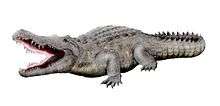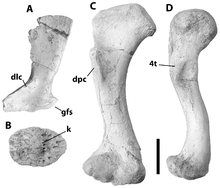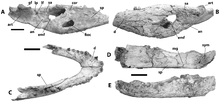Crocodylus anthropophagus
| Crocodylus anthropophagus Temporal range: 1.84 Ma | |
|---|---|
 | |
| Reconstruction of Crocodylus anthropophagus | |
| Scientific classification | |
| Kingdom: | Animalia |
| Phylum: | Chordata |
| Class: | Reptilia |
| Superorder: | Crocodylomorpha |
| Order: | Crocodilia |
| Family: | Crocodylidae |
| Subfamily: | Crocodylinae |
| Genus: | Crocodylus |
| Species: | C. anthropophagus |
| Binomial name | |
| Crocodylus anthropophagus Brochu et al., 2010 | |
Crocodylus anthropophagus is an extinct species of crocodile from Plio-Pleistocene from Tanzania. It lived 1.84 million years ago.[1] It was a large-sized apex predator reaching a length of 7.5 m (25 ft).[2]
Etymology
Crocodylus anthropophagus was first named by Christopher A. Brochu, Jackson Njau, Robert J. Blumenschine and Llewellyn D. Densmore in 2010. The specific name anthropophagus is from Greek word "anthropos" that means "human" and Greek word "phagos" that means "eater", in reference to the evidence that this animal included hominids in its diet.[1]
Distribution
The type locality is Plio-Pleistocene, Olduvai Gorge in the northern Tanzania. Its type locality is near the type localities for the hominids Homo habilis and Paranthropus boisei.[1]
Description

The description is based on the holotype, NNHM-OLD-1001, a partial skull and skeleton. Additional specimens include NHM R.5891, cranial and postcranial fragments, NHM R.5893, partial skull and skeleton, NHM R.5894, postcranial elements, KNM CROC K (Crocodile Korongo) OLD 62, partial skull, OLD 62 069/5866, right squamosal and quadrate ramus and OLD 1960, right postdentary elements of mandible.[1]
It had prominent triangular “horns” over the ears and a relatively deep snout, these resemble those of the recently extinct Malagasy crocodile Voay robustus, but the Crocodylus anthropophagus lacks features found among osteolaemines and shares derived similarities with living species of Crocodylus.[1]

Paleoecology
Crocodylus anthropophagus was the largest predator encountered by human ancestors at Olduvai Gorge, as indicated by hominid specimens preserving crocodile bite marks from these sites.[1]
References
This article incorporates CC-BY-2.5 text from the reference.[1]
- 1 2 3 4 5 6 7 Christopher A. Brochu, Jackson Njau, Robert J. Blumenschine and Llewellyn D. Densmore (2010). "A New Horned Crocodile from the Plio-Pleistocene Hominid Sites at Olduvai Gorge, Tanzania". PLoS ONE. 5 (2): e9333. doi:10.1371/journal.pone.0009333. PMC 2827537
 . PMID 20195356.
. PMID 20195356. - ↑ http://www.palaeocritti.com/by-group/crocodylomorpha/eusuchia/crocodylus on palaeocritti.com
External links
| Wikispecies has information related to: Crocodylus anthropophagus |
| Wikimedia Commons has media related to Crocodylus anthropophagus. |